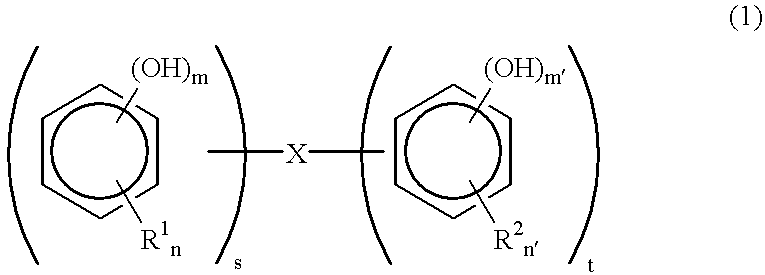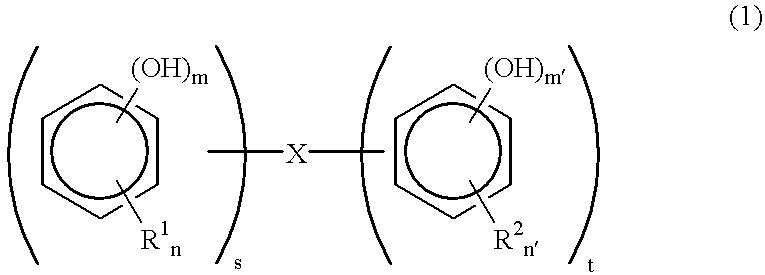Organohybrid-based damping material, method for producing the same, and damping improver for damping material
- Summary
- Abstract
- Description
- Claims
- Application Information
AI Technical Summary
Benefits of technology
Problems solved by technology
Method used
Image
Examples
example 1
[0100] A mixture of 30 wt. % of chlorinated polyethylene as the polymer matrix (hereinafter referred to as Matrix) and 60 wt. % of N,N-dicyclohexyl-2-benzothiazolysulfenamide as the material exhibiting piezoelectric, dielectric and electroconductive effects (hereinafter referred to as Additive 1) was first mixed by a two-roll mill at 40 to 60.degree. C. for 10 min. The mixture was then incorporated with 10 wt. % of 4,4'-Thio-bis(3-methyl-6-tert-butylphenol) having a molecular weight of 358.6 (hereinafter referred to as Additive 2), and well mixed at 70 to 90.degree. C. for 10 min. The mixture was preheated by a hot-pressing machine at 160.degree. C for 10 min and molded under a pressure of 19.6 MPa (200 Kgf / cm.sup.2) for 10 min, followed by quenching into water to obtain a damping material sheet with a thickness of 0.5 mm. The damping properties were measured immediately after the mixture was molded. To check the composition effect on the damping, a series of samples were also prepa...
example 2
[0101] A mixture of 30 wt. % of chlorinated polyethylene as Matrix and 60 wt. % of N,N-dicyclohexyl-2-benzothiazolysulfenamide as Additive 1 was first mixed by a two-roll mill at 40 to 60.degree. C. for 10 min. The mixture was then incorporated with 10 wt. % of 4,4'-Thio-bis(3-methyl-6-t-ert-butylphenol) as Additive 2), and well mixed at 70 to 90.degree. C. for 10 min. The mixture was preheated by a hot-pressing machine at 120.degree. C. for 10 min and molded under a pressure of 19.6 MPa (200 Kgf / cm.sup.2) for 10 min, followed by quenching into water to obtain a damping material sheet with a thickness of 0.5 mm. The damping properties were measured immediately after the mixture was molded. The evaluation results are given in FIG. 4 and Tables 1, 2.
example 3
[0102] A mixture of 45 wt. % of chlorinated polyethylene as Matrix and 45 wt. % of N,N-dicyclohexyl-2-benzothiazolysulfenamide as Additive 1 was first mixed by a two-roll mill at 40 to 60.degree. C. for 10 min. The mixture was then incorporated with 10 wt. % of 4,4'-Thio-bis(3-methyl-6-t-ert-butylphenol) having a molecular weight of 358.6 as Additive 2, and well mixed at 70 to 90.degree. C. for 10 min. The mixture was preheated by a hot-pressing machine at 120.degree. C. for 10 min and molded under a pressure of 19.6 MPa (200 Kgf / cm.sup.2) for 10 min, followed by quenching into water to obtain a damping material sheet with a thickness of 0.5 mm. The damping properties were measured immediately after the mixture was molded, and after the as-mold sheet was annealed at 50.degree. C. in a vacuum oven for several days. The evaluation results are given in FIGS. 4, 5, 6 and Tables 1, 2, 3, 4.
PUM
| Property | Measurement | Unit |
|---|---|---|
| Angle | aaaaa | aaaaa |
| Temperature | aaaaa | aaaaa |
| Temperature | aaaaa | aaaaa |
Abstract
Description
Claims
Application Information
 Login to View More
Login to View More - R&D
- Intellectual Property
- Life Sciences
- Materials
- Tech Scout
- Unparalleled Data Quality
- Higher Quality Content
- 60% Fewer Hallucinations
Browse by: Latest US Patents, China's latest patents, Technical Efficacy Thesaurus, Application Domain, Technology Topic, Popular Technical Reports.
© 2025 PatSnap. All rights reserved.Legal|Privacy policy|Modern Slavery Act Transparency Statement|Sitemap|About US| Contact US: help@patsnap.com



